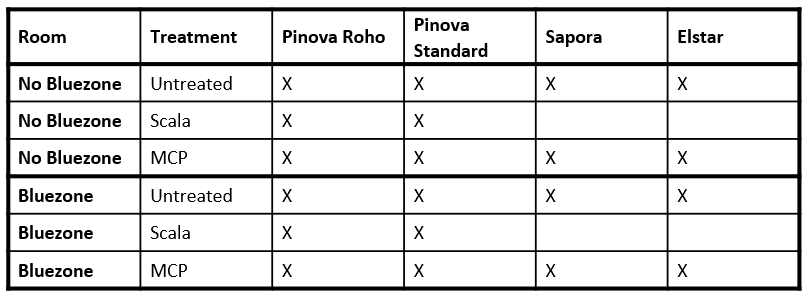Apple Study
Field Test of Apple Storage with Bluezone® Fresh Preservation Technology
Summary
In a three month field test, a storage room with Bluezone doubled the marketable apples compared to a storage room without.
Objective
Compare the ethylene concentration and quantity of marketable apples in cold storage rooms with and without Bluezone.
Methods and Materials
Four varieties of apples (Pinova Roho, Pinova Standard, Sapora, and Elstar) were stored in a climate-controlled storage facility for three months. Apples were untreated, treated with Scala, or treated with MCP in two rooms, one room with Bluezone and one room without Bluezone.

Both storage rooms were set to 3°C and 95% relative humidity. Temperature was raised to 10°C on 1/14. The temperature and ethylene content of the air were taken every week on Monday and Thursday. The ethylene concentration was checked using a Dräger X-am 5000.
Results
As time progressed, the storage room without a Bluezone saw an increase in ethylene concentration. The increase was most likely because the apples released ethylene (apples are ethylene producing fruits). The room with a Bluezone was able to maintain a very low ethylene level despite the apples constant release of ethylene.

To determine the effectiveness of Bluezone as a stand-alone product, compared are untreated Pinova Standard apples in the storage room without a Bluezone and untreated Pinova Standard apples in the storage room with a Bluezone. After three months of storage, untreated apples were removed from storage rooms on 3/04 and then stored for another week at 20°C. On 3/04, there was double the number of marketable apples in the room with a Bluezone compared to the room without a Bluezone. After an additional week of storage at 20°C, the room without a Bluezone had zero marketable apples compared to 36% marketable apples in the room with a Bluezone.

After three months of storage, on 3/04, untreated Elstar apples were removed from both storage rooms. 85% of untreated Elstar apples from the room without a Bluezone were marketable while 89% of untreated Elstar apples from the room with a Bluezone were marketable. After an additional week of storage at 20°C, on 3/11, 76% of untreated Elstar apples from the room without a Bluezone were marketable while 89% of untreated Elstar apples from the room with a Bluezone were marketable.
Conclusion
By destroying ethylene, Bluezone is able to maintain very low ethylene concentrations despite apples continuous production of ethylene into the contained storage room. The storage room with a Bluezone nearly doubled the amount of marketable Pinova Standard untreated apples compared to storage room without a Bluezone.
The power of Bluezone.
